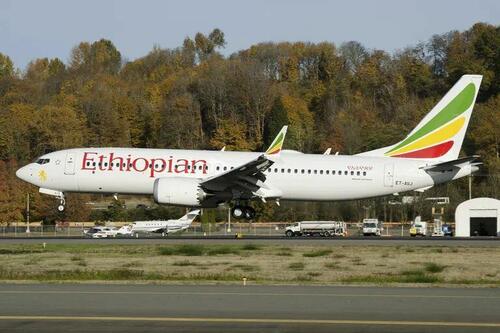New Boeing Whistleblower Docs Reveal Confusion And Chaos At Factory That Built Two Doomed 737 MAX Planes
New documents released Thursday reveal that ‘confusion and chaos’ reigned in the company’s Renton factory that built two 737 MAX planes that later crashed, killing 346 people in 2018 and 2019, the Seattle Times reports.
According to a prominent whistleblower Ed Pierson, production issues from back then still affect MAX planes flying today. The new documents reveal multiple electrical issues that were discovered as Boeing assembled the Ethiopian Airlines jet that crashed in 2019.
The Times notes that in 2018, the FAA found that employees in another Boeing facility in Everett, WA – where electrical components for integration – had been pushed to move to fast, and produced defective pieces.
Communications between Boeing and Ethiopian Airlines show the plane that later crashed experienced an in-flight safety incident months before the fatal accident. Boeing told the airline that the December 2018 incident was likely the result of an electrical error, the records show.
The whistleblower, Pierson, said the records and the earlier safety incident bolster his view that the deadly crash of the Ethiopian jet may have been initiated by an electrical problem. That problem traces back to production issues with electrical wire bundles that Pierson has highlighted.
Pierson, who worked at Boeing for more than a decade and served as a senior manager coordinating fixes for assembly problems on the 737 program, released the new documents through an advocacy group he formed after the crashes, the Foundation for Aviation Safety – and said that Boeing withheld the documents from regulatory investigators looking into the two deadly crashes.
Following the deadly incidents, he repeatedly alleged that manufacturing defects played a role.
The FAA, NTSB, and international regulators are in disagreement over the cause.
In both crashes, an error with then-new software — the Maneuvering Characteristics Augmentation System or MCAS — caused the plane to nosedive. Boeing recently pleaded guilty to misleading safety regulators about MCAS and how much training pilots would need to fly safely.
In the case of the Ethiopian crash, the NTSB and its French counterpart concluded that it wasn’t an electrical error but a bird strike damaging a sensor that likely triggered the MCAS software.
The U.S. agency disputed a report from Ethiopian authorities that said the sensor was triggered by “production quality defects.”
Pierson sent the newly disclosed records to the NTSB, the FAA and the Department of Justice in July, he said.
Meanwhile, the FAA and NTSB are playing hot potato over the new documents, and have suggested that questions should be directed to Ethiopian authorities.
Boeing, in a statement, said that it “fully cooperated and provided relevant information to the investigation” regarding the Ethiopian Airlines flight 302 crash, adding “We defer to the investigative agencies for further information.”
The new documents also reveal that from communications between Boeing and Ethiopian Airlines, in December 2018, the airline’s 737 MAX experienced an “uncommanded roll”—a situation where the plane rolls unexpectedly, potentially disorienting the pilot and risking loss of control. This incident occurred just weeks after Ethiopian Airlines took delivery of the aircraft, and only a few months before it tragically crashed, killing all onboard.
Boeing’s communication with the airline at the time indicated that the uncommanded roll was likely caused by an electrical fault. The company advised Ethiopian Airlines to inspect the plane’s wiring for issues, raising questions about the broader electrical integrity of the 737 MAX fleet.
Further complicating matters, the Foundation for Aviation Safety released a copy of Boeing’s Shipside Action Tracker from the 2018 production of the ill-fated Ethiopian Airlines plane. This internal database, used by Boeing to document and resolve issues during aircraft assembly, revealed a series of misinstalled and mislabeled electrical components. The records also pointed to significant miscommunication among Boeing employees regarding the work performed on the aircraft.
In a separate but related matter, a 2018 Federal Aviation Administration (FAA) investigation into Boeing’s Electrical Systems Responsibility Center in Everett, Washington, uncovered additional issues – which include Boeing management having imposed stringent time limits on employees, potentially leading to defective parts passing through the electrical center without proper inspection. Notably, the report highlighted that some parts had only one minute allocated for pre-inspection.
The investigation also criticized Boeing’s “rework” process—where components are disassembled and fixed before being reassembled—pointing out that this critical step was not always verified by quality assurance teams.
The new report reinforces the confusion and disarray reported at Boeing’s Renton factory following a separate incident in January – in which workers failed to secure a panel properly after removing it for repairs, leading to the panel blowing off a 737 MAX mid-flight at 16,000 feet. Boeing later admitted that it had no documented record of the work and rework performed on the panel.
Tyler Durden
Fri, 08/23/2024 – 09:40

